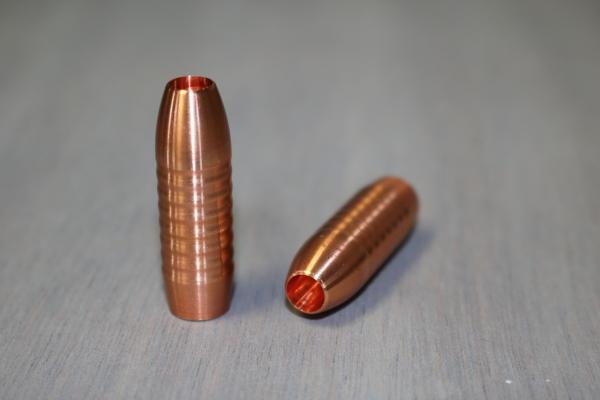I have posted this before so hope this helps.
My favourite bullet is the 350 grain RN Hornady. I have shot a lot of game with this bullet, from 1200 fps on up, you will get full pass through length wise on moose, elk or bear. I used a 45-70 as my primary rifle shooting bear control for 2 decades. I won't say how many bears I shot in that time, no one that doesn't know me would believe it, but in all the bears I shot I never had to track one very far and I can count on one hand the number I used two rounds on. Try for a speed of about 1600 fps. Faster will not improve your kill speed, it is the big hole not hydrostatic shock that does the job, the slower loads are far nicer to shoot and you do get a much faster second shot recovery if you ever actually need it.
I use magnum primers in my 45-70 loads as it gives a much cleaner and full burn. For brass WW, powder, 3031, Varget and 4227 have all been great performers.
Bone stock Marlin 45-70 Guide gun made in 2015.
JM 22" barrel Marlin 45-70 made around 1987
This is by Randy Garret of Garret Ammunition Manufacturers.
https://www.garrettcartridges.com/penetration.html
The following article is based on bullet penetration test results as measured in water-saturated penetration materials (wet newspapers). Water is the primary substance of life, and constitutes about 90% of the content of all mammals. I have observed that some "testers" have chosen wood boards or dry newspapers for penetration testing material, and this is a very poor choice, which in no way simulates the characteristics of a bullet impact with animal flesh. Wood tends to channel the bullet path, and is less demonstrative of the terminal instabilities inherent to non-expanding bullets when impacting game animals, and is thus an inferior material for the testing of bullet penetration characteristics. Water-saturated penetration materials such as newspapers or ballistic gelatin are far superior with regards to their ability to demonstrate the terminal instabilities that typically occur when non-expanding bullets impact live animal flesh. - Randy Garrett
There are few things in the world of ballistics less well understood than the issues relating to comparative penetration. It is commonly believed that the faster one drives a solid bullet, the deeper the penetration. We see this all the time in the various attempts, via new calibers, to achieve higher velocity for improved performance on heavy game. The current rage among big bore shooters seems to be the 458 Lott, since it achieves a good 200-300 fps higher velocity than the 458 Winchester Magnum. It is claimed that the new 458 Lott is an improvement over the 458 Winchester Magnum since its higher velocity supposedly results in more lethal impact-effect and deeper penetration. This, it is claimed, is just the ticket for busting the heaviest game. Of course, the new 458 Lott also achieves greater kinetic energy as a result of its higher velocity, and this is also a convincing characteristic for those brave souls in pursuit of the heaviest game.
Despite all the impressive "science" deployed to reinforce the assertion that higher speed projectiles are more capable of inflicting the deep penetration and impact-effect required to reliably anchor heavy game, one finds that these assertions simply do not withstand common sense, repeatable penetration testing. In fact, if one conducts these tests, one finds that there is nothing that can be observed which supports the assertion that the faster one drives non-expanding solids the deeper they penetrate.
Very interestingly, if one takes the Hornady 500-grain .458 diameter solid bullet and compares the penetration that results from impact speeds varying from about 1500-fps to 2500-fps, one finds that the higher impact speeds produce the least penetration. When driven to about 1500-fps (as the 45-70 will do) one finds that such solids produce nearly 6-feet of penetration in wet newspapers. When the same bullet is driven to about 2100-fps (as is characteristic of the 458 Winchester Magnum) one finds that the penetration is reduced to about 4 to 4 and 1/2 feet. When one tests the same bullet at 2300-2400 fps (as is characteristic of the 458 Lott) one finds that the penetration comes up nearly 20% short of that produced by the 458 Winchester. And when one tests the same bullet at the blistering speeds characteristic of the mighty 460 Weatherby Magnum, one finds that the penetration achieved is the most shallow produced by the various 458s.
What is apparent from testing is that penetration stops increasing at impact speeds above about 1250-1300 fps. When the impact speeds significantly surpass about 1600-fps, there is a very definite and measurable decrease in penetration depth. This raises some interesting issues regarding the relationship between kinetic energy generation and impact-effect. Although higher velocity projectiles always generate more kinetic energy they clearly do not produce deeper penetration, and when the velocities reach the levels common to today's magnums, the increases in velocity result in significantly reduced penetration. Simply stated, the faster they strike the faster they stop.
Fortunately for all of us who shoot the 45-70, it can be considered to be the deepest penetrating of the various 458 calibers. This is not due to any particular inherent superiority, but due to the 45-70's "inability" to achieve the velocity with heavy bullets that leads to decreases in penetration. The reasons why high impact speeds reduce penetration are not well understood. However, anyone who takes the time to run comparative penetration tests will find that those of us who pack a good 45-70 with heavy bullets need not take a back seat to any other 458 caliber, especially when the game is heavy and the penetration requirements are great.
- Randy Garrett
 Help Support Long Range Hunting Forum
Help Support Long Range Hunting Forum



hammerbullets.com

hammerbullets.com